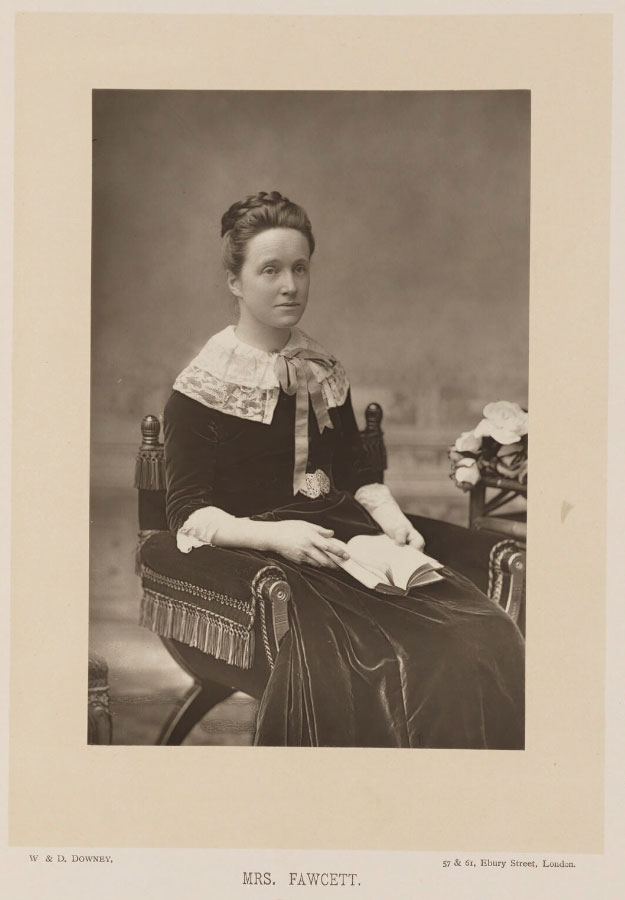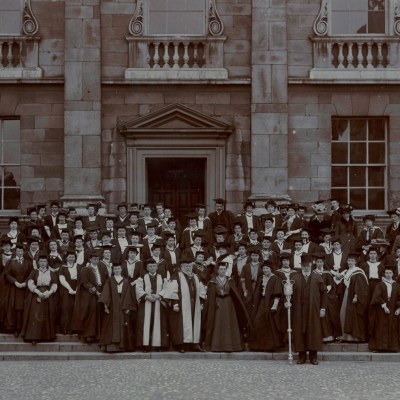Seated reading in a tidy study, a studious young woman looks up with an expression we can all relate to, in these days of makeshift offices and home-working. But this is not just any young woman. Recent research at Royal Holloway, University of London – part of a project I undertook as an Understanding British Portraits Fellow – has revealed that the interrupted worker in this portrait is in fact Millicent Fawcett, painted by Theodore Blake Wirgman in 1898, the year Fawcett became one of the first women to receive an honorary doctorate in the UK. Until now, she had been mistaken for another pioneering figure: Dame Emily Penrose, the inaugural principal of Bedford College, the first women’s college in the country. A gift from a leading Irish suffragist to Bedford College (now merged with Royal Holloway), this newly discovered portrait of Fawcett is a significant find for the history of suffrage and women’s education.
Millicent Garrett Fawcett (1847–1929) is best known today as a leading suffragist and campaigner, most notably as president of the National Union of Women’s Suffrage Societies (NUWSS). However she was also a passionate advocate for women’s access to education. Fawcett cofounded Newnham College, Cambridge, in 1875, and she lectured on higher education for women across the UK. When she received her honorary LLD from the University of St Andrews in 1898, it was cause for great celebration and great debate. We can only imagine the conversations that took place in front of this ‘good portrait of Mrs Henry Fawcett’ at the Royal Academy summer exhibition that year.
Millicent Fawcett (1898), Theodore Blake Wirgman. Royal Holloway, University of London

Its artist, Theodore Blake Wirgman (1848–1925), has been rather overlooked to date. Born into a progressive Swedish family, he studied at the Royal Academy Schools and later produced etched portraits for The Graphic and for Century magazine. Wirgman was part of a network of intellectuals who were sympathetic to the cause of women’s higher education, which was as divisive a subject as the suffrage movement. His portrait of Millicent Fawcett is likely to have been a commission from his aunt by marriage, Dorothea Roberts, the suffragist and old friend of Fawcett’s who gave the portrait to Bedford College in 1899.
The portrait is a significant addition to Fawcett’s iconography. Ford Madox Brown’s double portrait of Fawcett and her husband Henry Fawcett was painted when she was only 25. Later portraits by Annie Swynnerton and Lionel Ellis present Fawcett as an established authority, wearing the scarlet hood and black gown she received in honour of her LLD. Gillian Wearing’s monument, unveiled in Parliament Square in 2018, presents her at 60 years old, at the moment she became president of the NUWSS, holding a stitched banner with the maxim ‘courage calls to courage everywhere’ (her response to the death of Emily Davison at Epsom in 1913).
By contrast, Wirgman’s portrait presents Fawcett in her middle years and shows a quieter, more introspective side to a woman who is usually presented as a great campaigner. From Renaissance depictions of St Jerome onwards, scholars at work are often presented as solitary thinkers in a study-like environment, book in hand, isolated from the world. We interrupt Fawcett in a similar setting. Her heart-shaped face, simply styled auburn hair and fine bone structure give her a rather youthful appearance. She does not wear the regalia of her LLD. Instead she is dressed in the simple style that was favoured by female students and scholars at the end of the 19th century.
Millicent Fawcett photographed by W. & D. Downey, carbon print published by Cassell & Company, Ltd in 1890. Photo: © National Portrait Gallery, London (CC BY-NC-ND 3.0)

It is possible, likely even, that the portrait was painted from photographs not sittings, and Wirgman may not have seen Fawcett in person, let alone seen her wearing her new academic dress. But even if he had, academic dress would have been an unprecedented choice for a portrait of a woman. Many female scholars of this generation did not hold degrees despite stellar examination results. The University of London had offered degrees to women since 1878, but female students at Oxford and Cambridge had to wait until 1921 and 1948 respectively. Fawcett’s daughter Philippa, for example, scored the highest marks in the 1890 Cambridge mathematics tripos but did not receive a degree. In 1904 Trinity College Dublin opened its degrees to women, and offered degrees ad eundem to women who had passed Oxbridge examinations. Between 1904 and 1907, more than 700 women travelled to Dublin by steamboat to attend graduation ceremonies, before Trinity was overwhelmed by the number of these so-called ‘steamboat ladies’. One of the earliest portraits of a woman wearing academic dress depicts one of these women: Emily Penrose, painted by Philip de László in 1907 when she had left Bedford College and was serving as principal of Royal Holloway (she later took on the role at Somerville College in Oxford). In that painting, De László invents a new kind of portrait, drawing on baroque and neoclassical traditions in the drape of her Trinity hood across her body.
Emily Penrose (1907), Philip de László. Royal Holloway, University of London

Today, Wirgman’s portrait of Fawcett is held at Royal Holloway, which merged with Bedford College in 1985. A plaque on its frame attests that this studious young woman was until recently identified as Penrose. The sitter’s true identity was revealed only earlier this year, when close examination uncovered Wirgman’s signature, a reference to Dorothea Roberts’ gift was found in the college archives, and a reproduction of the portrait was located in the Royal Academy’s illustrated catalogue from 1898. Hanging on the wall at Bedford College in the first decades of the 20th century, this portrait would have inspired generations of progressive, ambitious women.
Imogen Tedbury is the Simon Sainsbury Curatorial Fellow at the National Gallery. She is the author of Royal Holloway’s upcoming catalogue of women academics’ portraits, which is funded by the Understanding British Portraits Subject Specialist Network.


